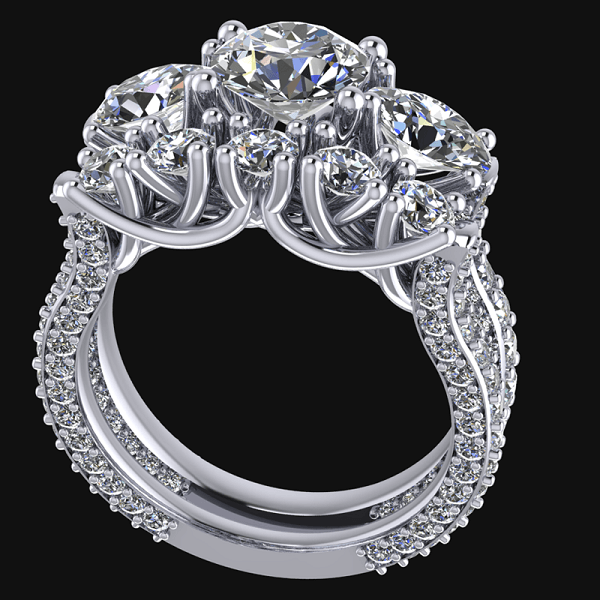Diamond Grading Guide, The 4 C's
Understanding Diamond Grading: The Four C’s & Using The Diamond Grading Guide
This week, let’s explore the essentials of the International Diamond Grading System with our comprehensive Diamond Grading. The Gemological Institute of America (GIA) developed the four C’s: Color, Clarity, Cut, and Carat weight. Therefore, these factors serve as the global standard for evaluating diamonds. By understanding these characteristics, you can make informed decisions. Whether you’re buying natural diamonds or lab grown diamonds, this guide will help you appreciate diamond quality. Furthermore, our diamond clarity & color chart will enhance your understanding. You can Explore Our Diamond Grading Guide here.

A Brief History of Diamond Grading
In the 1500s, merchants used vague terms to describe a diamond's value. However, these terms lacked consistency, confusing buyers. The term "carat," however, remained a standard weight measurement over time. Later, in the mid-20th century, the Gemological Institute of America (GIA) established a comprehensive diamond grading system. Consequently, this transformed how diamonds, including lab grown diamonds, were evaluated. As a result, our Diamond Grading Guide simplifies these standards. It helps you understand the key aspects of diamond quality using the diamond clarity and color chart.
Learn More About Diamond Clarity Chart by GIA.
The Four C's Explained
-
Cut
The cut directly influences a diamond’s brilliance. It determines how well light is reflected within the stone. Additionally, a well-cut diamond offers maximum sparkle. For example, cuts range from "Excellent" to "Poor." In our Diamond Grading Guide, we emphasize the importance of cut. It is crucial whether you’re buying natural or lab grown diamond. Moreover, the diamond clarity chart color complements the cut, revealing a diamond's complete beauty. -
Carat Weight
Carat weight measures the size of a diamond. One carat equals 0.2 grams. However, carat weight alone doesn’t determine a diamond’s value. Other factors like cut, color, and clarity also matter. Furthermore, precision is essential, as carat weight is measured to the hundredth decimal place. Larger diamonds are rarer and usually more valuable. Use our Diamond Grading to understand how carat weight interacts with the diamond clarity & color chart. -
Color
The GIA color scale ranges from D (colorless) to Z (light yellow or brown). Colorless diamonds allow maximum light refraction. Nevertheless, color differences can be subtle, requiring a trained eye. The diamond clarity and color chart guides you through these nuances. Lab grown diamonds are graded using the same chart. For example, a D-grade diamond is completely colorless. On the other hand, an H-grade diamond may have slight warmth, noticeable only upon close inspection. -
Clarity
Clarity refers to internal or external flaws, called inclusions and blemishes. The clarity scale ranges from Flawless to Included. Therefore, fewer inclusions mean higher clarity and increased value. Most diamonds have some inclusions. However, they often have minimal impact on appearance. The diamond clarity chart color in our guide explains how clarity affects natural and lab grown diamonds. Consequently, it ensures clear differentiation between diamonds with similar grades.
Why a Diamond Grading Guide Matters
Using a Diamond Grading Guide helps you make informed decisions. It explains how each of the four C’s influences a diamond’s quality. Additionally, the diamond clarity and color chart makes comparisons easier. For instance, if you’re evaluating two diamonds of the same carat weight, use the diamond clarity chart color. This approach helps determine which diamond has better clarity or color.
At BVW Jewelers, we prioritize transparency. Our experts use the Diamond Grading Guide to explain each diamond’s grade. Whether you choose natural or lab grown diamonds, we provide accurate information. This approach ensures you find the perfect diamond for your needs, guided by the diamond clarity and color chart.
Tips for Choosing the Right Diamond Using The Diamond Grading Guide
When buying diamonds, prioritize the cut. It affects a diamond’s sparkle the most. Next, consider color and clarity. Moreover, use the diamond clarity and color chart for detailed comparisons. This method ensures value and quality for your budget.
Conclusion
Understanding the four C's—Color, Clarity, Cut, and Carat weight—is crucial. Therefore, the Diamond Grading Guide at BVW Jewelers makes the buying process clear and transparent. Whether it’s natural or lab grown diamonds, trust our guide to make informed choices. Visit our Diamond Grading Guide page to learn more. Furthermore, explore the diamond clarity and color chart and browse our diamond collection today.




